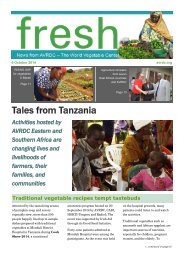allowing them to ensure a secure supply of food and other materials.15.16.17.18.19.20.21.22.We, farmers, have contributed to and have been strong innovators since the advent of agriculture since ancient times. For instance, by implementing watersystem in impervious areas, improving the resilience of plants through grafting or even, adopting appealing packaging for presenting products. In this context,innovation is essential at the farm level and throughout the agricultural product supply chain, including the adoption of technologies to increase output andefficiency, increased traceability in the food supply chain, branding, marketing of products, the quality and the origin of agricultural products, and many othersfactors that contribute to success.Farmers need access to the market assured by an enabling framework, which grants investments in qualitative and reliable infrastructure for transport, shipping,warehousing, cooperative models, which facilitate their full involvement in the value chain allowing to exploit the full benefit of the system. This will contribute tothe reduction of food losses and increase efficiencies along supply chains.We, farmers, need access to the ability to acquire appropriate knowledge and skills to make continuous improvements to agricultural sustainability. Investmentsin education and capacity building will provide lasting returns. Farmers need the possibilities to acquire the appropriate knowledge and to become trueentrepreneurs. This is because the economic dimension of sustainable development is important as well as the social and environmental ones.We, farmers, require reasonable farm gate prices. In a food supply chain where farmers are clasped between the dealers and the input providers, farmers aremost often price takers with little bargaining power constraining our adaptability to the market. We are grateful for the ear and the confidence of consumers andwould like to develop this relationship. Acting collectively in cooperatives farmers are better able to take advantage of market opportunities and mitigate thenegative effects of food and other crises, but more needs to be done in terms of policies, transparent legislation, incentives and opportunities. We need all thesupport and creative thinking as we can to improve the farmers’ position in the value chain. Without strong farm gate prices and a fair remuneration for what weproduce there is no attractiveness, no renewable energy, no food security and no development in poor rural areas.The key issue to meet our challenges is to deliver profitability at the farm level. This ensures that farming remains a viable, sustainable career option for youngpeople and supports transitioning between generations. Profitability is needed for agriculture to be able to compete with alternative employment in the city andto make further investments in the social and environmental pillars of sustainability.Finally, the right to farm must leave the possibility to regions to develop their own agricultural potential. Focus on competitiveness cannot be at the expense ofdeveloping farming potential in other regions. Assuring the right to develop its own agricultural potential contributes to the goal of reducing inequality amongcountries. It also contributes to the achievement of food security and broadens the variety and hence resilience of the agrifood system as a whole. This goal mustbe shared by all stakeholders in the society. In this perspective, this must be recognized as a public good.In too many fora, at national, regional and international levels, farmers are marginalized and deprived of the right to speak and be listened to. We, farmers, needthe ear of decisionmakers. Policy makers must talk and listen to farmers rather than speak about farmers without us present.We, farmers, have and will continue to Feed the Planet and produce Energy for Life.
<strong>WFO</strong> F@rmletterEDITORIALFAO’S SUPPORTFOR THRIVINGRURAL PRODUCERORGANIZATIONS ANDCOOPERATIVESJosé Graziano da SilvaFAO DIRECTOR-GENERAL2<strong>2015</strong> marks the end of theMillennium DevelopmentGoals cycle and the beginningof the SustainableDevelopment era. We cancelebrate the fact that72 countries reached theMDG 1 hunger target of halving theproportion of undernourished peoplebetween 1990 and <strong>2015</strong>. Worldwide,the number of hungry people inthe world has dropped by 216 million.We are going in the right direction butthere is no time for complacency: 795million remain hungry and the commitmentthat we must make – and aremaking – with the Sustainable DevelopmentGoals (SDGs) is to eradicatehunger and malnutrition.Farmers, and especially family andsmall-scale farmers and their organizations,have a central role to play inthis effort: they are the main food producersin most of the countries in theworld. At the same time, around 70%of the food-insecure worldwide live inrural areas in developing countries, andmost of them are subsistence farmerswho struggle to feed their families.As indicated in the 2014 State of Foodand Agriculture, more than nine out often farms in the world are family farms,representing the dominant formof farming in most countries. Thereare more than 500 million farms in theworld, of which at least 500 million areowned by an individual or a family andrely primarily on family labour. 72%of these farms in the world have lessthan 1 hectare of land. Although theyare the ones that manage the majorityof the world’s agricultural land andproduce most of the world’s food, theyface many challenges that reduce theircapacity to become food secure. Weaktenure rights as well as poor access tomarkets, natural resources, technologies,knowledge and financial servicesare only a few of these challenges.In order to face them, small-scale farmers,fisher folks, livestock keepersand forest users in developing countriesneed support. In the two last decades,new forms of organizational innovationshave emerged to provide aresponse to the numerous constraintsthat small producers face in rural areas.They range from formal organizationscovered by national legislation,such as cooperatives, producer organizationsand national farmers’ unions,to more informal self-help groups andassociations. This kind of farmer-ledcollective action has proven to be aviable solution for reducing povertyand eradicating hunger, food insecurityand malnutrition in most developingcountries.In particular, cooperatives and producerorganizations, as independent,non-governmental, democraticallycontrolled and member-driven ruralorganizations, have proved to be an effectivemeans for increasing agriculturalproductivity as well as for meetingsmall producers’ social and economicneeds.7



